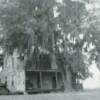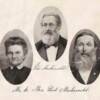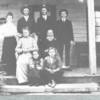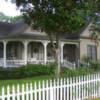History
Your place in Texas history.
Michael Machemehl, a member of the German Forty-Eighters, led his family and companions, to the present day area of Bellville, Texas from the German city of Annaberg, Saxony in 1849. The Forty-Eighters were Germans who traveled to the United States and Australia after the Revolutions of 1848. Michael was married to Charlotte Marschner. They had two children, Emilie Bertha and Johann.
The Machemehl family purchased the land which now comprises Sycamore Hill in 1849.
Henrietta, wife of Johann, was a French Huguenot born in Switzerland and was a governess for the family of a Russian prince of Courland whose estate was on the Baltic. She met John Machemehl in Saxony while traveling with the Russian Family.
Johann had a university education and was forester for the city of Annaberg in Saxony.
When Henrietta and Johann made the 10-week sailing voyage to America, Henrietta brought with them a china set which now is in storage with family members.
Henrietta died in 1850 and was the first person buried in the family cemetery located next to Hillview Road within Sycamore Hill. Johann married twice more, had four more children and died in 1880. Johann is also buried in the family cemetery. Inscriptions on their head stones are in German.
Johann (1816-1880) and Henrietta's son Paul Machemehl (1845-1932) is known for his participation in the passage to Mexico that numerous German Texans endured during the American Civil War. Documents located at the Eula and David Wintermann Library in Eagle Lake, Texas report that local German Texans were "discussing the hostility between the North and the South with Paul Machemehl of Bellville. Many Germans did not believe this was their fight and many joined Paul Machemehl.
Many Germans in Central Texas were born in a German state. They tended to support the Union and had few slaves. Gillespie and other central Hill Country counties had voted against secession.
With a need for more soldiers, the Confederacy established a draft. The Germans did not want to fight against the Union and objected to being drafted. Buildup to this event began in the spring of 1862 with the initiation of a Confederate Conscription for Texans, to which many German Texans voiced their objection.. In Texas the most adamant supporters of the Union were Tejanos and the German Texans both from Central Texas and the counties of the Texas Hill Country including: Gillespie County, Kerr County, Kendall County, Medina County, and Bexar County.
.
As word spread of these counties' objections, Confederate authorities declared central Texas to be under martial law.. Many German Texans of both regions decided to go to Mexico to avoid being drafted on the wrong side. By August, a party of 61 German Texans from the Hill Country counties, who were fleeing to Mexico, was overtaken by the Texas Confederate Cavalry
on the Nueces River. Shots were fired and as a result 34 German Texans were killed, with some being executed after being taken prisoner.. The Germans from Central Texas were fortunate to avoid such violence. They successfully traveled to Mexico City under the leadership of Paul Machemehl.
The Treüe der Union ("Loyalty to the Union") monument to the German Texans slain at the Nueces massacre was dedicated on August 10, 1866 and sits in Comfort, Texas, where the remains of the Unionists are interred. It is the oldest Civil War monument in Texas and the only one dedicated to Union sympathizers in all of the former Confederate States of AmericaConfederate States of America (apart from national cemeteries).
Sam Houston was probably the premier "Unionist" in Texas. Like most of the same in the South, he strongly believed in the doctrine of states rights, and even assured his fellow Texans he would personally lead the state out of the Union should matters justify such. However, he thought secession at the moment in time was "rash action," and certain to lead to a conflict sure to favor - in the long run - the industrial and populated North. He predicted: "Let me tell you what is coming. After the sacrifice of countless millions of treasure and hundreds of thousands of lives you may win Southern independence, but I doubt it. The North is determined to preserve this Union. They are not a fiery impulsive people as we are...but once they begin to move in a given direction, they move with the steady momentum of a mighty avalanche, and what I fear is that they will overwhelm the South with ignoble defeat."
Paul Machemehl returned from Mexico to become a successful farmer and cattleman and acquired land in other parts of the county before leaving the farm in 1913 to live in Bellville. Paul married Hermine Brune of the adjoining Colorado county, also of German immigrant stock, in 1881. Paul and Hermine had six children. In the early 1900s Paul and Hermine built a house located at 1034 South Tesch in Bellville.
Paul and Henrietta's son, Louis A. Machemehl (1881-1952), a prominent civic leader and successful land and cattle broker, was vice-president of Austin County State Bank, horseman of note, and owner of the third automobile in Bellville. Louis married Adelheid Reichardt (1882-1949) of Cat Spring. She was the daughter of Charles Reichardt (1852-1882), a Colorado County farmer who died a month before Adelheid was born on August 24, 1882. According to early church records, Louis A. was named Johann Ludwig Arnold.
Louis and Adelheid built a craftsman house in Bellville in 1920. The house has a historical marker with the following text: A significant example of the Craftsman bungalow designed by prominent Houston architect Alfred C. Finn, this house is unusual for its one-and-one-half story form. The residence displays hallmark geometric ornamentation, broad porches, and a small second floor that rises above the first floor roofline in a form sometimes called "airplane bungalow". Built in 1920 for prominent rancher and civic leader Louis A. Machemehl (1881-1952), his wife Adelheid (d. 1949), and their five children, the house was a center of social activity. It remained in the Machemehl family until 1953. Recorded Texas Historic Landmark - 1992. The house is located at 621 E. O'Bryant Street in Bellville. The architect's original watercolor rendition and floor plans are in the archives of the Houston Public Library.
Some of the Machemehl family history contained herein was taken from a web site maintained by Johann and Henrietta's great great grandson, Deric Bownds.
Photos of the Machemehl home and first settlers. Click on a photo to view the gallery.



